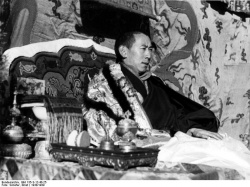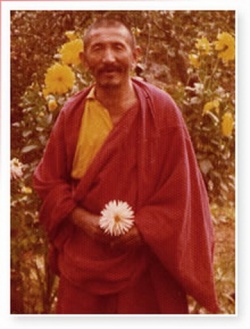Difference between revisions of "The Mysterious Figures 9 and 13"
m (Text replacement - "southwest" to "{{Wiki|southwest}}") |
m (Text replacement - "Lhasa" to "{{Wiki|Lhasa}}") |
||
| Line 5: | Line 5: | ||
THE NUMBER NINE AND ITS MULTIPLES. | THE NUMBER NINE AND ITS MULTIPLES. | ||
| − | The Han and [[Tibetan]] {{Wiki|ethnic}} groups as well as some {{Wiki|ethnic}} groups in {{Wiki|southwest}} [[China]] consider the number "9" to be [[auspicious]]. The [[Temple]] of [[Heaven]] in {{Wiki|Beijing}}, for example, has a circular [[altar]] consisting of three layers, each layer with nine circles. Nine stones slabs or multiples of nine were used to pave each of the circles. In [[Tibetan]] areas, [[people]] favor the odd-numbered days of the first half of a month, and shun the remaining days. When presenting gifts to friends, they give gifts in odd numbers, amounting to at most 9 or 13. They never present gifts in plural numbers. According to the [[Tibetans]], their ancestor had 9 brothers, the [[Heavenly]] [[God]] has 9 heads, and [[King]] Gesar used 9 arrows to shoot 9 rams and 9 ewes. When [[offering]] a toast, the [[Tibetans]] drink three cups of wine three times. Numbers that are multiples of nine, including 18, 36, 72, 81, and [[108]], are also considered [[auspicious]]. The [[Jokhang]] [[Monastery]] in | + | The Han and [[Tibetan]] {{Wiki|ethnic}} groups as well as some {{Wiki|ethnic}} groups in {{Wiki|southwest}} [[China]] consider the number "9" to be [[auspicious]]. The [[Temple]] of [[Heaven]] in {{Wiki|Beijing}}, for example, has a circular [[altar]] consisting of three layers, each layer with nine circles. Nine stones slabs or multiples of nine were used to pave each of the circles. In [[Tibetan]] areas, [[people]] favor the odd-numbered days of the first half of a month, and shun the remaining days. When presenting gifts to friends, they give gifts in odd numbers, amounting to at most 9 or 13. They never present gifts in plural numbers. According to the [[Tibetans]], their ancestor had 9 brothers, the [[Heavenly]] [[God]] has 9 heads, and [[King]] Gesar used 9 arrows to shoot 9 rams and 9 ewes. When [[offering]] a toast, the [[Tibetans]] drink three cups of wine three times. Numbers that are multiples of nine, including 18, 36, 72, 81, and [[108]], are also considered [[auspicious]]. The [[Jokhang]] [[Monastery]] in {{Wiki|Lhasa}} is held up by [[108]] pillars, and according to [[Tibetan Buddhist]] [[teaching]], mankind suffers from [[108]] types of concerns that can be eliminated by the [[power]] of [[Buddhism]]. |
THE FIGURE 13 IN CHINA AND THE WEST. | THE FIGURE 13 IN CHINA AND THE WEST. | ||
| Line 14: | Line 14: | ||
The [[Temple]] of [[Heaven]] in {{Wiki|Beijing}} has a circular [[altar]] consisting of three layers, each layer with nine circles. Nine stone slabs or multiples of nine were used to pave each of the circles. | The [[Temple]] of [[Heaven]] in {{Wiki|Beijing}} has a circular [[altar]] consisting of three layers, each layer with nine circles. Nine stone slabs or multiples of nine were used to pave each of the circles. | ||
| − | The [[Jokhang]] [[Monastery]] in | + | The [[Jokhang]] [[Monastery]] in {{Wiki|Lhasa}} is held up by [[108]] pillars, and according to [[Tibetan Buddhist]] [[teaching]], mankind suffers from [[108]] types of concerns that can be eliminated by the [[power]] of [[Buddhism]]. |
In some Western nations the number 13 is regarded as unlucky. The [[Tibetans]], however, regard the number 13 as holy. | In some Western nations the number 13 is regarded as unlucky. The [[Tibetans]], however, regard the number 13 as holy. | ||
</poem> | </poem> | ||
Revision as of 20:33, 12 September 2013
There are figures that appear in philosophy, religion, stories, poems and local customs that embody more than their numerical significance, and they are thus referred to as "mysterious" or "magical" figures or formulae. Most of these figures are odd numbers, and a few are the sum or multiples of "mysterious" numbers. For example, the numbers 9 and 13 are considered of special significance by the Han and Tibetan ethnic groups.
THE NUMBER NINE AND ITS MULTIPLES.
The Han and Tibetan ethnic groups as well as some ethnic groups in southwest China consider the number "9" to be auspicious. The Temple of Heaven in Beijing, for example, has a circular altar consisting of three layers, each layer with nine circles. Nine stones slabs or multiples of nine were used to pave each of the circles. In Tibetan areas, people favor the odd-numbered days of the first half of a month, and shun the remaining days. When presenting gifts to friends, they give gifts in odd numbers, amounting to at most 9 or 13. They never present gifts in plural numbers. According to the Tibetans, their ancestor had 9 brothers, the Heavenly God has 9 heads, and King Gesar used 9 arrows to shoot 9 rams and 9 ewes. When offering a toast, the Tibetans drink three cups of wine three times. Numbers that are multiples of nine, including 18, 36, 72, 81, and 108, are also considered auspicious. The Jokhang Monastery in Lhasa is held up by 108 pillars, and according to Tibetan Buddhist teaching, mankind suffers from 108 types of concerns that can be eliminated by the power of Buddhism.
THE FIGURE 13 IN CHINA AND THE WEST.
In some Western nations the number 13 is regarded as unlucky. In the Netherlands, for example, it is difficult to find a house numbered 13, and in theaters in the United Kingdom and the United States there are no rows or seats numbered 13. When it is necessary to have 13, "2A" is often used as a substitute. People often avoid going out on the 13th of the month and never have 13 people seated for supper. The Tibetans, however, regard the number 13 as holy. According to King Gesar, the world's longest epic, when Gesar was born he held 13 flowers in his hands, walked 13 steps and vowed to become a Buddha at 13. Indeed, when he was 13, he was victorious in a horse race, married and became king of the state of Ling. Also according to King Gesar, Gesar had 13 concubines and 13 Buddhist guardians, and in the state of Ling under his rule there were 13 snowy mountains, 13 mountain ridges, and 13 lakes.
COINCIDENCE
The Temple of Heaven in Beijing has a circular altar consisting of three layers, each layer with nine circles. Nine stone slabs or multiples of nine were used to pave each of the circles.
The Jokhang Monastery in Lhasa is held up by 108 pillars, and according to Tibetan Buddhist teaching, mankind suffers from 108 types of concerns that can be eliminated by the power of Buddhism.
In some Western nations the number 13 is regarded as unlucky. The Tibetans, however, regard the number 13 as holy.

